child seat Alfa Romeo Giulia 2019 Owner's Manual
[x] Cancel search | Manufacturer: ALFA ROMEO, Model Year: 2019, Model line: Giulia, Model: Alfa Romeo Giulia 2019Pages: 232, PDF Size: 4.87 MB
Page 21 of 232
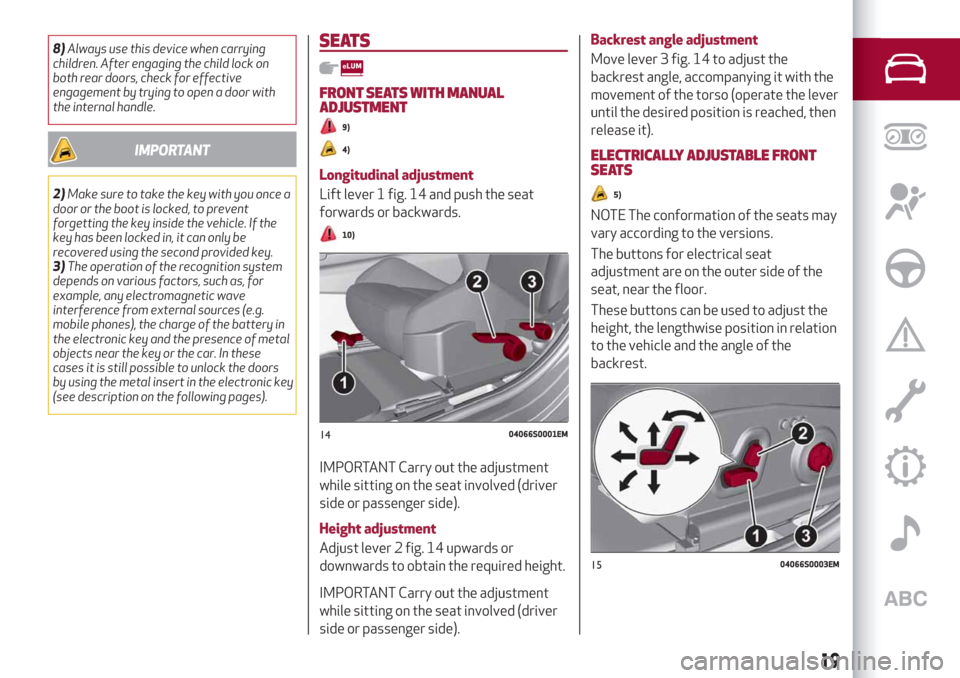
8)Always use this device when carrying
children. After engaging the child lock on
both rear doors, check for effective
engagement by trying to open a door with
the internal handle.
IMPORTANT
2)Make sure to take the key with you once a
door or the boot is locked, to prevent
forgetting the key inside the vehicle. If the
key has been locked in, it can only be
recovered using the second provided key.
3)The operation of the recognition system
depends on various factors, such as, for
example, any electromagnetic wave
interference from external sources (e.g.
mobile phones), the charge of the battery in
the electronic key and the presence of metal
objects near the key or the car. In these
cases it is still possible to unlock the doors
by using the metal insert in the electronic key
(see description on the following pages).
SEATS
FRONT SEATS WITH MANUAL
ADJUSTMENT
9)
4)
Longitudinal adjustment
Lift lever 1 fig. 14 and push the seat
forwards or backwards.
10)
IMPORTANT Carry out the adjustment
while sitting on the seat involved (driver
side or passenger side).
Height adjustment
Adjust lever 2 fig. 14 upwards or
downwards to obtain the required height.
IMPORTANT Carry out the adjustment
while sitting on the seat involved (driver
side or passenger side).
Backrest angle adjustment
Move lever 3 fig. 14 to adjust the
backrest angle, accompanying it with the
movement of the torso (operate the lever
until the desired position is reached, then
release it).
ELECTRICALLY ADJUSTABLE FRONT
SEATS
5)
NOTE The conformation of the seats may
vary according to the versions.
The buttons for electrical seat
adjustment are on the outer side of the
seat, near the floor.
These buttons can be used to adjust the
height, the lengthwise position in relation
to the vehicle and the angle of the
backrest.
1404066S0001EM
1504066S0003EM
19
Page 73 of 232
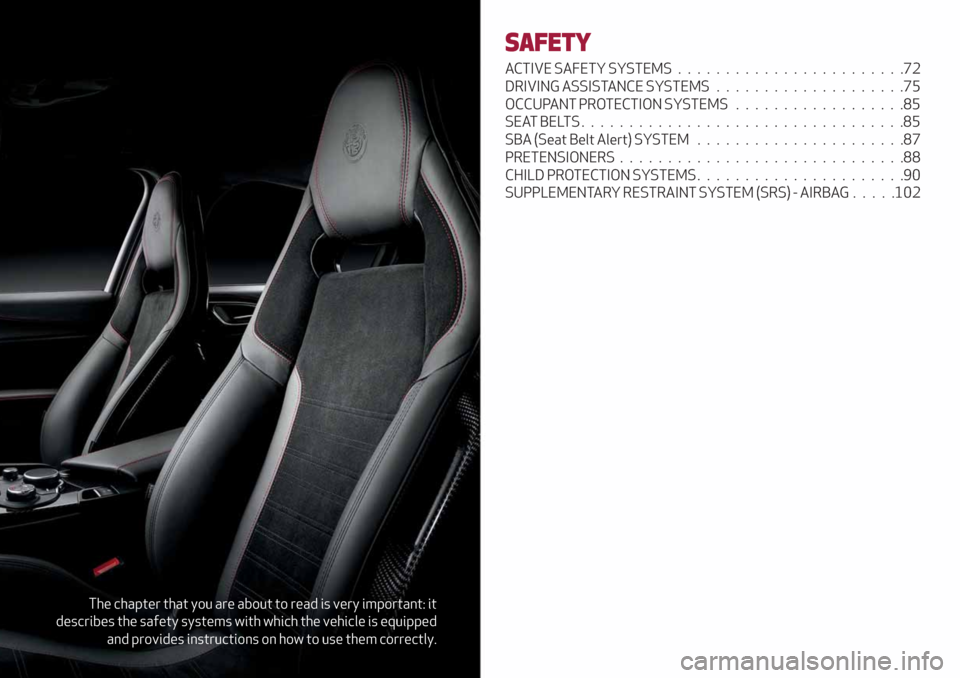
The chapter that you are about to read is very important: it
describes the safety systems with which the vehicle is equipped
and provides instructions on how to use them correctly.
SAFETY
ACTIVE SAFETY SYSTEMS........................72
DRIVING ASSISTANCE SYSTEMS....................75
OCCUPANT PROTECTION SYSTEMS..................85
SEATBELTS..................................85
SBA (Seat Belt Alert) SYSTEM......................87
PRETENSIONERS..............................88
CHILD PROTECTION SYSTEMS......................90
SUPPLEMENTARY RESTRAINT SYSTEM (SRS) - AIRBAG.....102
Page 87 of 232
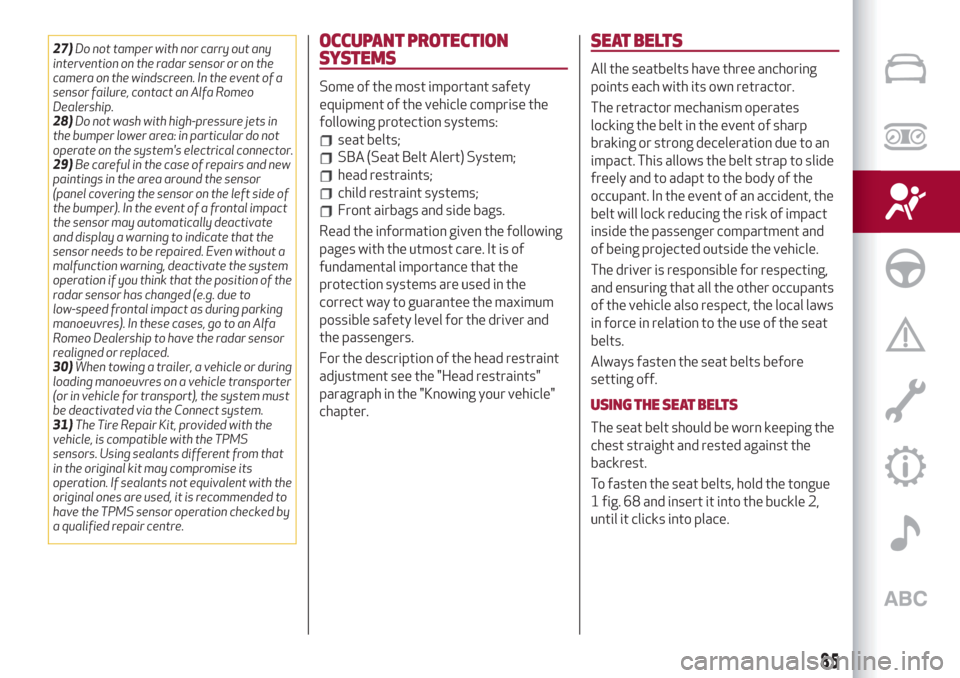
27)Do not tamper with nor carry out any
intervention on the radar sensor or on the
camera on the windscreen. In the event of a
sensor failure, contact an Alfa Romeo
Dealership.
28)Do not wash with high-pressure jets in
the bumper lower area: in particular do not
operate on the system's electrical connector.
29)Be careful in the case of repairs and new
paintings in the area around the sensor
(panel covering the sensor on the left side of
the bumper). In the event of a frontal impact
the sensor may automatically deactivate
and display a warning to indicate that the
sensor needs to be repaired. Even without a
malfunction warning, deactivate the system
operation if you think that the position of the
radar sensor has changed (e.g. due to
low-speed frontal impact as during parking
manoeuvres). In these cases, go to an Alfa
Romeo Dealership to have the radar sensor
realigned or replaced.
30)When towing a trailer, a vehicle or during
loading manoeuvres on a vehicle transporter
(or in vehicle for transport), the system must
be deactivated via the Connect system.
31)The Tire Repair Kit, provided with the
vehicle, is compatible with the TPMS
sensors. Using sealants different from that
in the original kit may compromise its
operation. If sealants not equivalent with the
original ones are used, it is recommended to
have the TPMS sensor operation checked by
a qualified repair centre.OCCUPANT PROTECTION
SYSTEMS
Some of the most important safety
equipment of the vehicle comprise the
following protection systems:
seat belts;
SBA (Seat Belt Alert) System;
head restraints;
child restraint systems;
Front airbags and side bags.
Read the information given the following
pages with the utmost care. It is of
fundamental importance that the
protection systems are used in the
correct way to guarantee the maximum
possible safety level for the driver and
the passengers.
For the description of the head restraint
adjustment see the "Head restraints"
paragraph in the "Knowing your vehicle"
chapter.
SEAT BELTS
All the seatbelts have three anchoring
points each with its own retractor.
The retractor mechanism operates
locking the belt in the event of sharp
braking or strong deceleration due to an
impact. This allows the belt strap to slide
freely and to adapt to the body of the
occupant. In the event of an accident, the
belt will lock reducing the risk of impact
inside the passenger compartment and
of being projected outside the vehicle.
The driver is responsible for respecting,
and ensuring that all the other occupants
of the vehicle also respect, the local laws
in force in relation to the use of the seat
belts.
Always fasten the seat belts before
setting off.
USING THE SEAT BELTS
The seat belt should be worn keeping the
chest straight and rested against the
backrest.
To fasten the seat belts, hold the tongue
1 fig. 68 and insert it into the buckle 2,
until it clicks into place.
85
Page 90 of 232
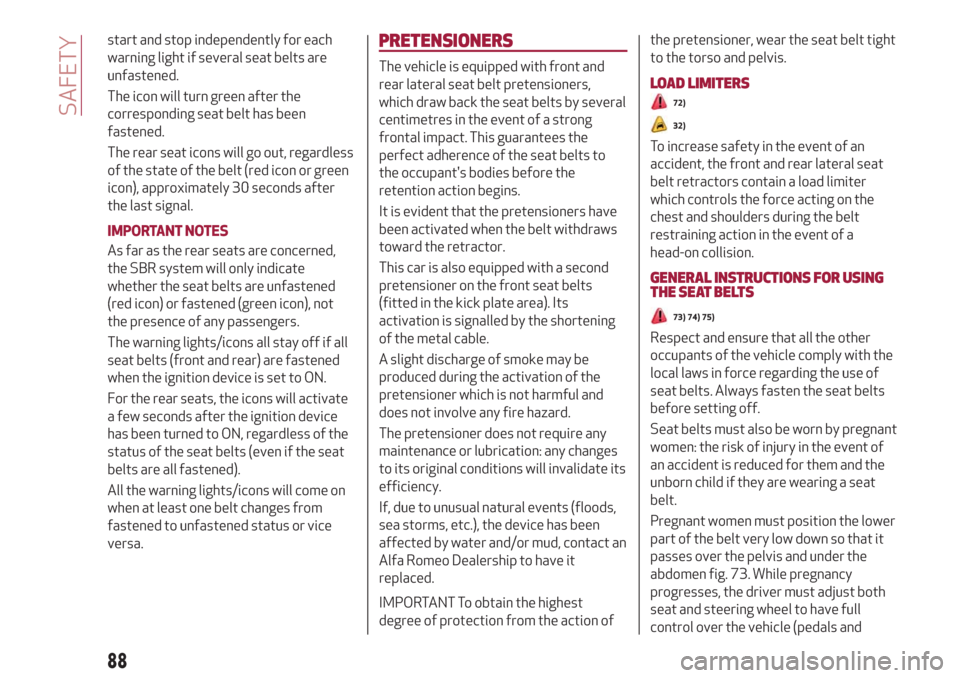
start and stop independently for each
warning light if several seat belts are
unfastened.
The icon will turn green after the
corresponding seat belt has been
fastened.
The rear seat icons will go out, regardless
of the state of the belt (red icon or green
icon), approximately 30 seconds after
the last signal.
IMPORTANT NOTES
As far as the rear seats are concerned,
the SBR system will only indicate
whether the seat belts are unfastened
(red icon) or fastened (green icon), not
the presence of any passengers.
The warning lights/icons all stay off if all
seat belts (front and rear) are fastened
when the ignition device is set to ON.
For the rear seats, the icons will activate
a few seconds after the ignition device
has been turned to ON, regardless of the
status of the seat belts (even if the seat
belts are all fastened).
All the warning lights/icons will come on
when at least one belt changes from
fastened to unfastened status or vice
versa.PRETENSIONERS
The vehicle is equipped with front and
rear lateral seat belt pretensioners,
which draw back the seat belts by several
centimetres in the event of a strong
frontal impact. This guarantees the
perfect adherence of the seat belts to
the occupant's bodies before the
retention action begins.
It is evident that the pretensioners have
been activated when the belt withdraws
toward the retractor.
This car is also equipped with a second
pretensioner on the front seat belts
(fitted in the kick plate area). Its
activation is signalled by the shortening
of the metal cable.
A slight discharge of smoke may be
produced during the activation of the
pretensioner which is not harmful and
does not involve any fire hazard.
The pretensioner does not require any
maintenance or lubrication: any changes
to its original conditions will invalidate its
efficiency.
If, due to unusual natural events (floods,
sea storms, etc.), the device has been
affected by water and/or mud, contact an
Alfa Romeo Dealership to have it
replaced.
IMPORTANT To obtain the highest
degree of protection from the action ofthe pretensioner, wear the seat belt tight
to the torso and pelvis.
LOAD LIMITERS
72)
32)
To increase safety in the event of an
accident, the front and rear lateral seat
belt retractors contain a load limiter
which controls the force acting on the
chest and shoulders during the belt
restraining action in the event of a
head-on collision.
GENERAL INSTRUCTIONS FOR USING
THE SEAT BELTS
73) 74) 75)
Respect and ensure that all the other
occupants of the vehicle comply with the
local laws in force regarding the use of
seat belts. Always fasten the seat belts
before setting off.
Seat belts must also be worn by pregnant
women: the risk of injury in the event of
an accident is reduced for them and the
unborn child if they are wearing a seat
belt.
Pregnant women must position the lower
part of the belt very low down so that it
passes over the pelvis and under the
abdomen fig. 73. While pregnancy
progresses, the driver must adjust both
seat and steering wheel to have full
control over the vehicle (pedals and
88
SAFETY
Page 91 of 232
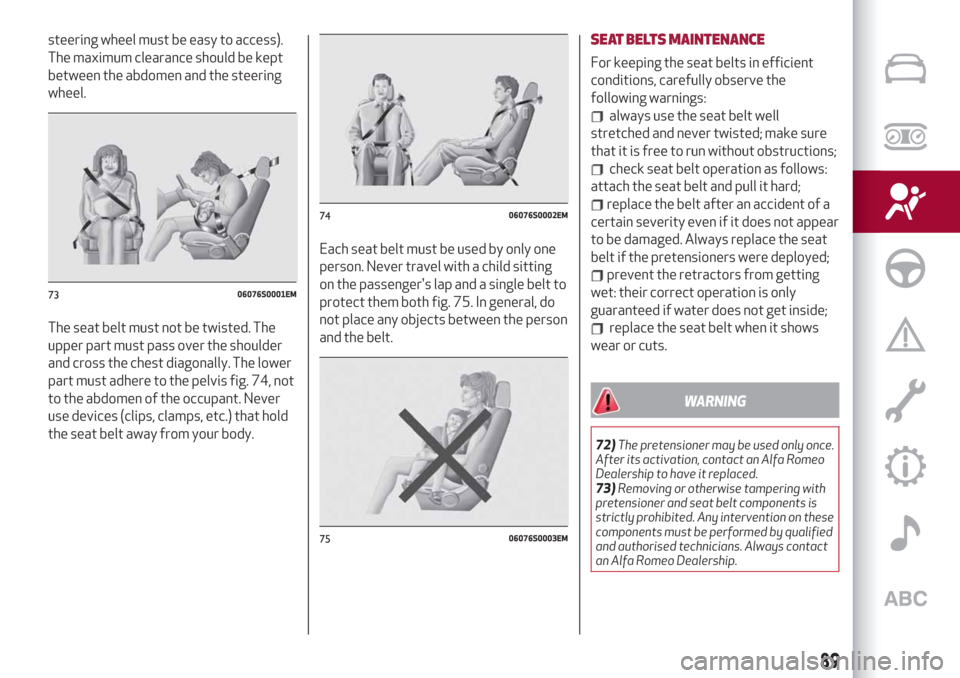
steering wheel must be easy to access).
The maximum clearance should be kept
between the abdomen and the steering
wheel.
The seat belt must not be twisted. The
upper part must pass over the shoulder
and cross the chest diagonally. The lower
part must adhere to the pelvis fig. 74, not
to the abdomen of the occupant. Never
use devices (clips, clamps, etc.) that hold
the seat belt away from your body.Each seat belt must be used by only one
person. Never travel with a child sitting
on the passenger's lap and a single belt to
protect them both fig. 75. In general, do
not place any objects between the person
and the belt.SEAT BELTS MAINTENANCE
For keeping the seat belts in efficient
conditions, carefully observe the
following warnings:
always use the seat belt well
stretched and never twisted; make sure
that it is free to run without obstructions;
check seat belt operation as follows:
attach the seat belt and pull it hard;
replace the belt after an accident of a
certain severity even if it does not appear
to be damaged. Always replace the seat
belt if the pretensioners were deployed;
prevent the retractors from getting
wet: their correct operation is only
guaranteed if water does not get inside;
replace the seat belt when it shows
wear or cuts.
WARNING
72)The pretensioner may be used only once.
After its activation, contact an Alfa Romeo
Dealership to have it replaced.
73)Removing or otherwise tampering with
pretensioner and seat belt components is
strictly prohibited. Any intervention on these
components must be performed by qualified
and authorised technicians. Always contact
an Alfa Romeo Dealership.
7306076S0001EM
7406076S0002EM
7506076S0003EM
89
Page 92 of 232
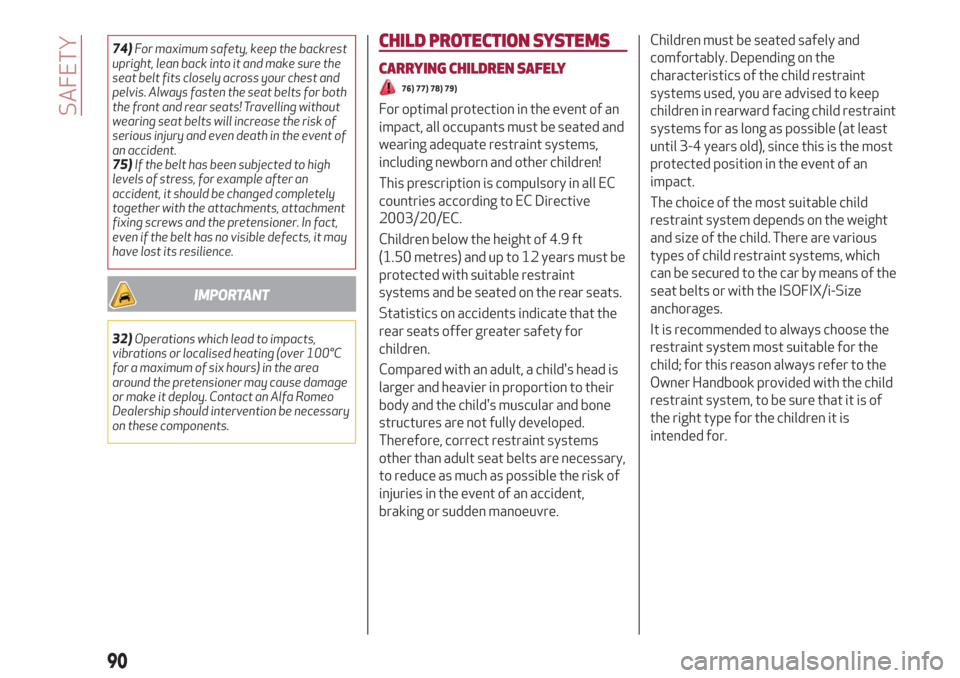
74)For maximum safety, keep the backrest
upright, lean back into it and make sure the
seat belt fits closely across your chest and
pelvis. Always fasten the seat belts for both
the front and rear seats! Travelling without
wearing seat belts will increase the risk of
serious injury and even death in the event of
an accident.
75)If the belt has been subjected to high
levels of stress, for example after an
accident, it should be changed completely
together with the attachments, attachment
fixing screws and the pretensioner. In fact,
even if the belt has no visible defects, it may
have lost its resilience.
IMPORTANT
32)Operations which lead to impacts,
vibrations or localised heating (over 100°C
for a maximum of six hours) in the area
around the pretensioner may cause damage
or make it deploy. Contact an Alfa Romeo
Dealership should intervention be necessary
on these components.
CHILD PROTECTIONSYSTEMS
CARRYING CHILDREN SAFELY
76) 77) 78) 79)
For optimal protection in the event of an
impact, all occupants must be seated and
wearing adequate restraint systems,
including newborn and other children!
This prescription is compulsory in all EC
countries according to EC Directive
2003/20/EC.
Children below the height of 4.9 ft
(1.50 metres) and up to 12 years must be
protected with suitable restraint
systems and be seated on the rear seats.
Statistics on accidents indicate that the
rear seats offer greater safety for
children.
Compared with an adult, a child's head is
larger and heavier in proportion to their
body and the child's muscular and bone
structures are not fully developed.
Therefore, correct restraint systems
other than adult seat belts are necessary,
to reduce as much as possible the risk of
injuries in the event of an accident,
braking or sudden manoeuvre.Children must be seated safely and
comfortably. Depending on the
characteristics of the child restraint
systems used, you are advised to keep
children in rearward facing child restraint
systems for as long as possible (at least
until 3-4 years old), since this is the most
protected position in the event of an
impact.
The choice of the most suitable child
restraint system depends on the weight
and size of the child. There are various
types of child restraint systems, which
can be secured to the car by means of the
seat belts or with the ISOFIX/i-Size
anchorages.
It is recommended to always choose the
restraint system most suitable for the
child; for this reason always refer to the
Owner Handbook provided with the child
restraint system, to be sure that it is of
the right type for the children it is
intended for.
90
SAFETY
Page 93 of 232
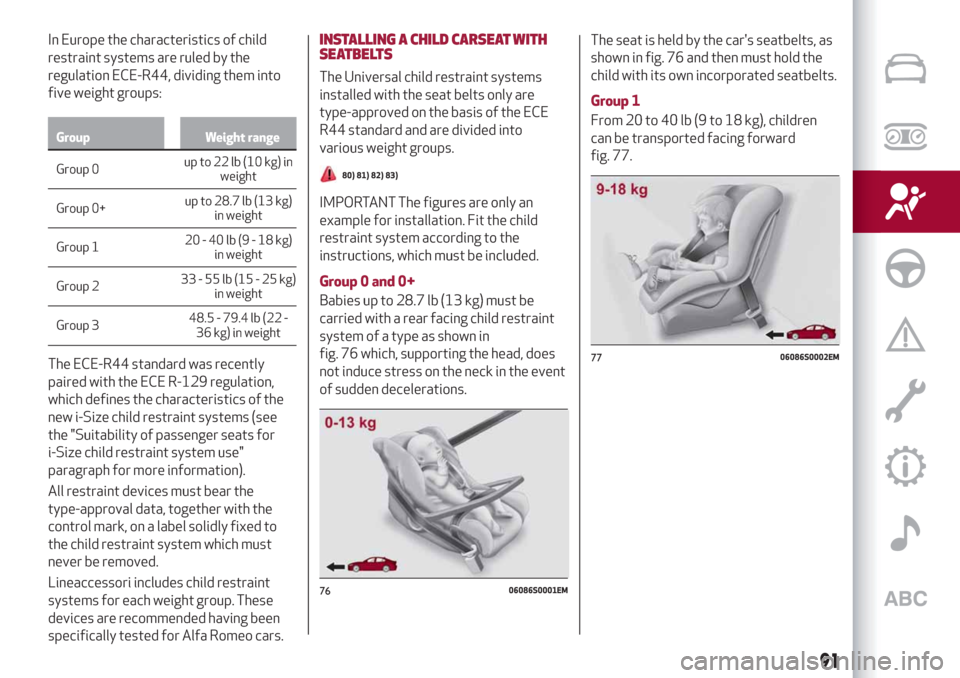
In Europe the characteristics of child
restraint systems are ruled by the
regulation ECE-R44, dividing them into
five weight groups:
Group Weight range
Group 0up to 22 lb (10 kg) in
weight
Group 0+up to 28.7 lb (13 kg)
in weight
Group 120-40lb(9-18kg)
in weight
Group 233-55lb(15-25kg)
in weight
Group 348.5 - 79.4 lb (22 -
36 kg) in weight
The ECE-R44 standard was recently
paired with the ECE R-129 regulation,
which defines the characteristics of the
new i-Size child restraint systems (see
the "Suitability of passenger seats for
i-Size child restraint system use"
paragraph for more information).
All restraint devices must bear the
type-approval data, together with the
control mark, on a label solidly fixed to
the child restraint system which must
never be removed.
Lineaccessori includes child restraint
systems for each weight group. These
devices are recommended having been
specifically tested for Alfa Romeo cars.
INSTALLING A CHILD CARSEAT WITH
SEATBELTS
The Universal child restraint systems
installed with the seat belts only are
type-approved on the basis of the ECE
R44 standard and are divided into
various weight groups.
80) 81) 82) 83)
IMPORTANT The figures are only an
example for installation. Fit the child
restraint system according to the
instructions, which must be included.
Group 0 and 0+
Babies up to 28.7 lb (13 kg) must be
carried with a rear facing child restraint
system of a type as shown in
fig. 76 which, supporting the head, does
not induce stress on the neck in the event
of sudden decelerations.The seat is held by the car's seatbelts, as
shown in fig. 76 and then must hold the
child with its own incorporated seatbelts.
Group 1
From 20 to 40 lb (9 to 18 kg), children
can be transported facing forward
fig. 77.
7606086S0001EM
7706086S0002EM
91
Page 94 of 232
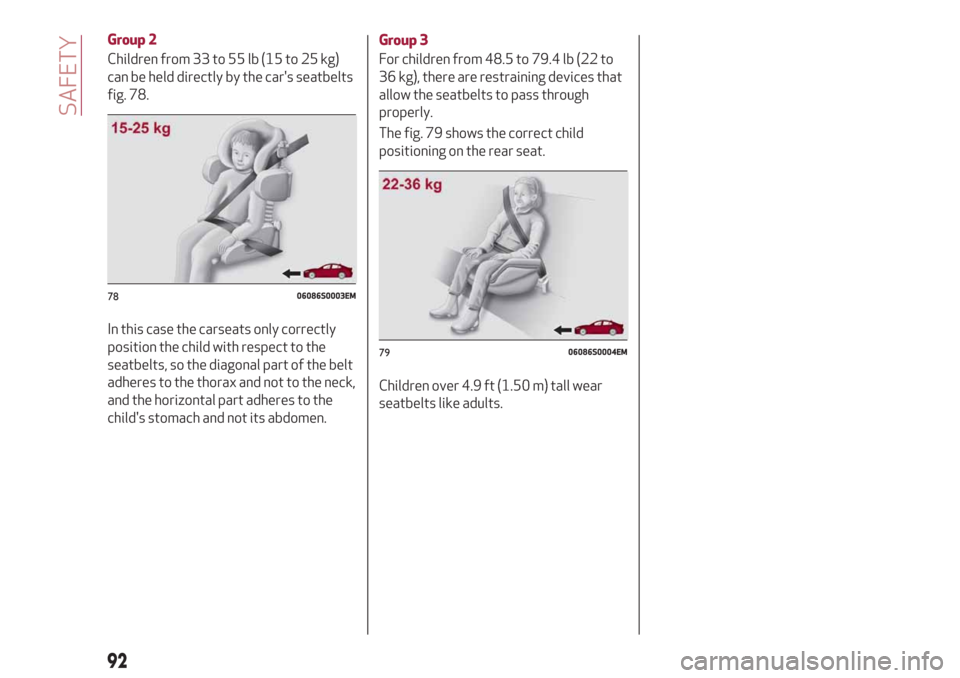
Group 2
Children from 33 to 55 lb (15 to 25 kg)
can be held directly by the car's seatbelts
fig. 78.
In this case the carseats only correctly
position the child with respect to the
seatbelts, so the diagonal part of the belt
adheres to the thorax and not to the neck,
and the horizontal part adheres to the
child's stomach and not its abdomen.Group 3
For children from 48.5 to 79.4 lb (22 to
36 kg), there are restraining devices that
allow the seatbelts to pass through
properly.
The fig. 79 shows the correct child
positioning on the rear seat.
Children over 4.9 ft (1.50 m) tall wear
seatbelts like adults.
7806086S0003EM
7906086S0004EM
92
SAFETY
Page 95 of 232
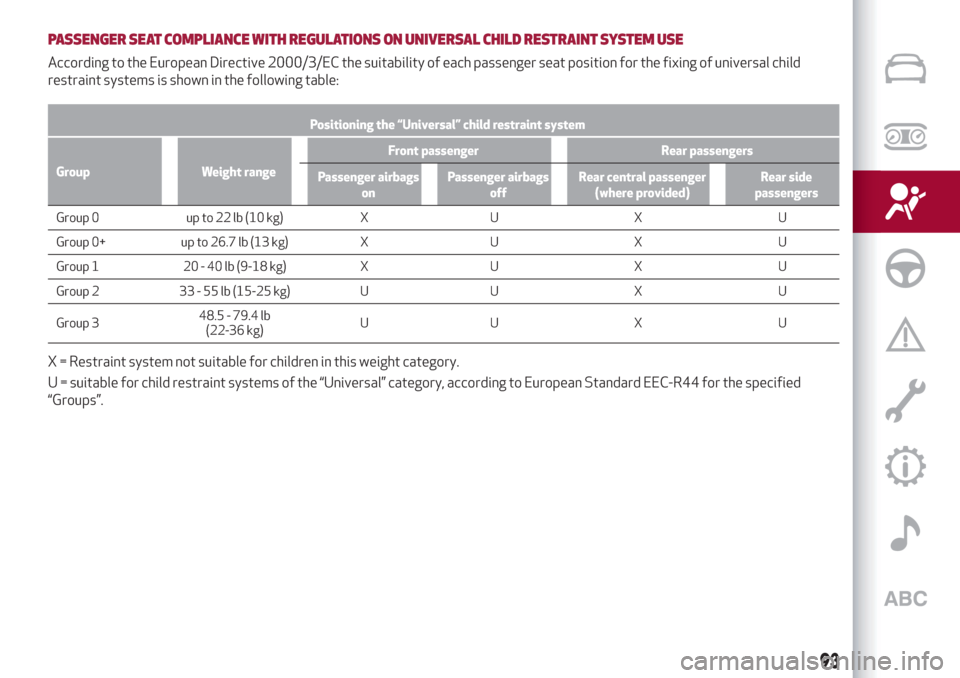
PASSENGER SEAT COMPLIANCE WITH REGULATIONS ON UNIVERSAL CHILD RESTRAINTSYSTEM USE
According to the European Directive 2000/3/EC the suitability of each passenger seat position for the fixing of universal child
restraint systems is shown in the following table:
Positioning the “Universal” child restraint system
Group Weight rangeFront passenger Rear passengers
Passenger airbags
onPassenger airbags
offRear central passenger
(where provided)Rear side
passengers
Group 0 up to 22 lb (10 kg) X U X U
Group 0+ up to 26.7 lb (13 kg) X U X U
Group 1 20 - 40 lb (9-18 kg) X U X U
Group 2 33 - 55 lb (15-25 kg) U U X U
Group 348.5 - 79.4 lb
(22-36 kg)UUXU
X = Restraint system not suitable for children in this weight category.
U = suitable for child restraint systems of the “Universal” category, according to European Standard EEC-R44 for the specified
“Groups”.
93
Page 96 of 232
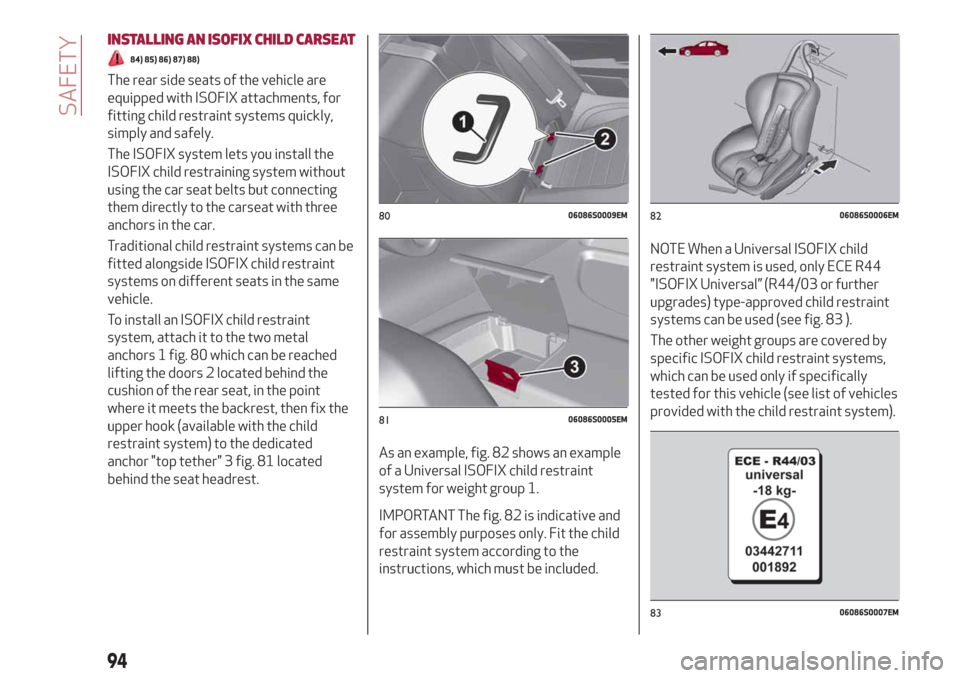
INSTALLING AN ISOFIX CHILD CARSEAT
84) 85) 86) 87) 88)
The rear side seats of the vehicle are
equipped with ISOFIX attachments, for
fitting child restraint systems quickly,
simply and safely.
The ISOFIX system lets you install the
ISOFIX child restraining system without
using the car seat belts but connecting
them directly to the carseat with three
anchors in the car.
Traditional child restraint systems can be
fitted alongside ISOFIX child restraint
systems on different seats in the same
vehicle.
To install an ISOFIX child restraint
system, attach it to the two metal
anchors 1 fig. 80 which can be reached
lifting the doors 2 located behind the
cushion of the rear seat, in the point
where it meets the backrest, then fix the
upper hook (available with the child
restraint system) to the dedicated
anchor "top tether" 3 fig. 81 located
behind the seat headrest.As an example, fig. 82 shows an example
of a Universal ISOFIX child restraint
system for weight group 1.
IMPORTANT The fig. 82 is indicative and
for assembly purposes only. Fit the child
restraint system according to the
instructions, which must be included.
NOTE When a Universal ISOFIX child
restraint system is used, only ECE R44
"ISOFIX Universal” (R44/03 or further
upgrades) type-approved child restraint
systems can be used (see fig. 83 ).
The other weight groups are covered by
specific ISOFIX child restraint systems,
which can be used only if specifically
tested for this vehicle (see list of vehicles
provided with the child restraint system).
8006086S0009EM
8106086S0005EM
8206086S0006EM
8306086S0007EM
94
SAFETY